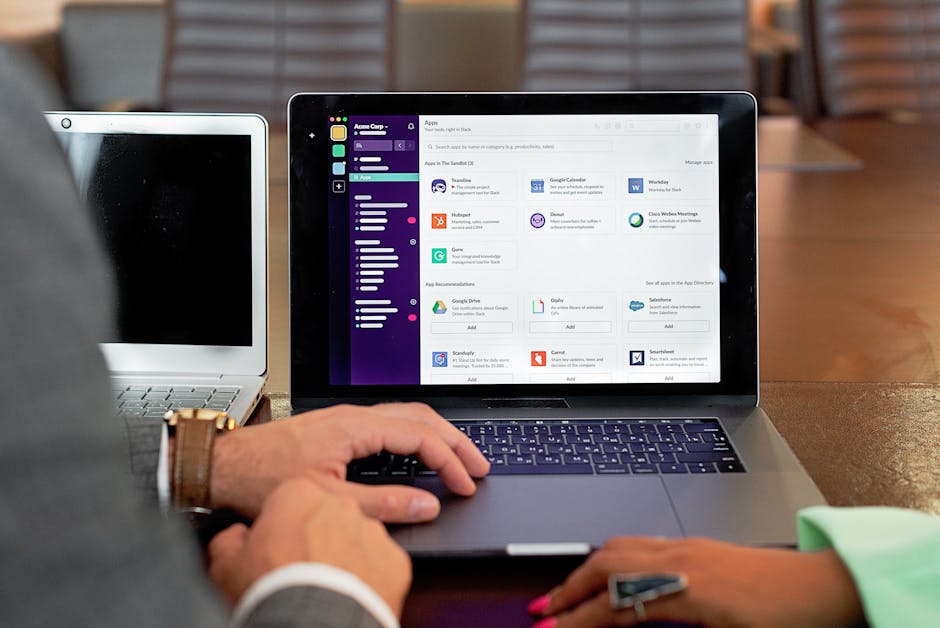Maximizing Team Efficiency: The Ultimate Guide to Collaboration Tools
“In today's fast-paced business environment, effective collaboration is the cornerstone of organizational success. This comprehensive guide explores how modern collaboration tools can transform workplace productivity, streamline communication, and foster innovation across remote, hybrid, and in-office teams. Learn how to select the right solutions for your organization's unique needs. ”

Maximizing Team Efficiency: The Ultimate Guide to Collaboration Tools
In today's dynamic business landscape, the ability for teams to work together seamlessly—regardless of physical location—has become a critical competitive advantage. Modern collaboration tools have transformed how organizations operate, enabling unprecedented levels of productivity, creativity, and efficiency across distributed workforces.

The Evolution of Workplace Collaboration
The concept of workplace collaboration has undergone a dramatic transformation in recent years. What once required physical presence in meeting rooms has evolved into sophisticated digital ecosystems that support real-time interaction and information sharing across time zones and geographies.
Modern collaboration tools serve as the backbone of productive remote work environments, enabling instant communication through chat, video conferencing, screen sharing, and message boards. These platforms have become essential for maintaining team cohesion and productivity in an increasingly distributed work world.
Key Benefits of Effective Collaboration Tools
Enhanced Productivity and Efficiency
One of the primary advantages of implementing robust collaboration tools is the significant boost to productivity. By optimizing workflows and automating repetitive tasks, these platforms allow teams to focus on value-added activities rather than administrative busywork.
Research consistently shows that organizations with well-implemented collaboration systems experience:
- Reduced time spent searching for information
- Faster decision-making processes
- Decreased email overload
- Streamlined approval workflows
- Improved task tracking and accountability
Improved Communication Across Teams
Effective collaboration tools break down silos between departments and facilitate cross-functional teamwork. They create centralized spaces where team members can share ideas, provide feedback, and maintain visibility into ongoing projects regardless of their physical location.
Knowledge Sharing and Retention
Perhaps one of the most valuable aspects of modern collaboration platforms is their ability to serve as repositories for organizational knowledge. These systems can capture, organize, and make searchable the collective expertise of your workforce, preventing critical information from being lost when employees transition out of roles.

Essential Types of Collaboration Tools
Project Management Platforms
Project management tools like Asana, ClickUp, and monday.com provide teams with comprehensive solutions for planning, organizing, and tracking work. These platforms typically offer features such as:
- Task assignment and tracking
- Timeline visualization
- Resource allocation
- Progress monitoring
- Custom workflow creation
These tools help teams maintain clarity around responsibilities, deadlines, and project status, reducing confusion and ensuring accountability.
Communication Platforms
Communication tools form the foundation of effective collaboration, especially for remote and hybrid teams. These platforms typically include:
- Instant messaging
- Video conferencing
- Screen sharing capabilities
- File sharing
- Voice calls
The right communication tools can dramatically reduce email overload while fostering more natural, conversational interactions among team members.
Document Collaboration Solutions
Document collaboration tools allow multiple team members to work on the same files simultaneously, eliminating version control issues and streamlining the content creation process. These platforms typically offer:
- Real-time editing
- Comment and suggestion functionality
- Version history tracking
- Permission controls
- Integration with storage systems
By implementing effective knowledge management systems through document collaboration, organizations can create centralized repositories of information that improve decision-making and preserve institutional knowledge.
Visual Collaboration Tools
Visual collaboration tools like digital whiteboards and design platforms enable teams to brainstorm, plan, and create together in visual formats. These tools are particularly valuable for:
- Creative ideation sessions
- Process mapping
- User journey design
- System architecture planning
- Visual storytelling
Selecting the Right Collaboration Tools for Your Organization
Choosing the optimal collaboration stack requires careful consideration of your organization's specific needs, workflows, and culture. Here are key factors to evaluate:
Assess Your Team's Specific Needs
Before implementing any new tools, take time to understand your team's current pain points and collaboration requirements. Consider:
- What types of work do your teams typically collaborate on?
- Where are the current bottlenecks in your collaboration processes?
- What existing tools are working well, and which ones are causing friction?
- How technically savvy is your workforce?
Integration Capabilities
The best collaboration tools don't exist in isolation—they integrate seamlessly with your existing technology stack. Look for platforms that offer robust APIs and pre-built integrations with your current systems to avoid creating new silos of information.

Scalability and Security
As your organization grows, your collaboration needs will evolve. Select tools that can scale with your business and provide the necessary security features to protect sensitive information. This is particularly important for organizations in regulated industries or those handling confidential data.
Key security considerations include:
- Data encryption (both in transit and at rest)
- Role-based access controls
- Single sign-on capabilities
- Compliance certifications (GDPR, HIPAA, etc.)
- Audit logging
User Experience and Adoption
Even the most powerful collaboration tool will fail if your team doesn't use it. Prioritize solutions with intuitive interfaces and comprehensive training resources to ensure high adoption rates. Consider conducting pilot programs with representative user groups before rolling out new tools organization-wide.
Implementing Collaboration Tools Successfully
Successful implementation of collaboration tools requires more than just selecting the right technology—it demands thoughtful change management and ongoing optimization.
Develop a Clear Implementation Strategy
Create a structured implementation plan that includes:
- Defined objectives and success metrics
- Phased rollout schedule
- Training and support resources
- Communication plan for introducing new tools
- Feedback mechanisms for continuous improvement
Foster a Collaborative Culture
Technology alone cannot create collaboration—it requires a supportive organizational culture. Leaders should model collaborative behaviors and recognize team members who effectively utilize the new tools to drive better outcomes.
Provide Comprehensive Training
Invest in thorough training programs that go beyond basic functionality to show team members how the new tools fit into their daily workflows. Consider appointing "power users" within each department who can provide peer support and champion adoption.
Measure and Optimize
Regularly assess how your collaboration tools are performing against your defined objectives. Collect both quantitative metrics (usage statistics, productivity measures) and qualitative feedback to identify opportunities for optimization.
Overcoming Common Collaboration Challenges
Even with the best tools in place, teams may encounter challenges in their collaboration efforts. Here are strategies for addressing common obstacles:
Information Overload
With the proliferation of collaboration channels, team members can quickly become overwhelmed by notifications and information. Combat this by:
- Establishing clear guidelines for which tools should be used for different types of communication
- Encouraging judicious use of notification settings
- Creating structured information architecture within your tools
- Implementing regular digital cleanup practices
Remote and Hybrid Team Dynamics
Distributed workforce models present unique collaboration challenges. Address these by:
- Creating explicit norms for communication and availability
- Scheduling regular synchronous touchpoints
- Using tools with strong asynchronous capabilities
- Being mindful of time zone differences
- Fostering social connection through virtual team-building activities
Balancing Collaboration and Focus Time
Constant collaboration can impede deep work. Help team members find balance by:
- Designating collaboration-free focus time on calendars
- Setting expectations around response times
- Creating "do not disturb" protocols
- Using asynchronous communication methods when immediate responses aren't necessary
The Future of Collaboration Tools
The landscape of collaboration tools continues to evolve rapidly, with several emerging trends shaping the future:
AI-Enhanced Collaboration
Artificial intelligence is increasingly being integrated into collaboration tools to:
- Automate routine tasks and workflow optimization
- Provide smart suggestions and content recommendations
- Transcribe and summarize meetings
- Translate content in real-time for global teams
- Surface relevant information when needed
Immersive Collaboration Experiences
Virtual and augmented reality technologies are creating more immersive collaboration experiences that better approximate in-person interaction. These technologies show particular promise for:
- Design reviews and 3D modeling
- Training and simulation
- Virtual office environments
- Spatial computing applications
Unified Collaboration Platforms
The trend toward consolidation is likely to continue, with organizations seeking comprehensive platforms that combine communication, project management, document collaboration, and other functions in unified experiences.

Conclusion: Building a Collaborative Future
As work continues to evolve, effective collaboration tools will remain essential for organizational success. By thoughtfully selecting, implementing, and optimizing these tools, organizations can create environments where teams thrive regardless of physical location.
The most successful organizations will be those that view collaboration tools not just as technological solutions, but as enablers of human connection, creativity, and collective intelligence. By combining the right technology with supportive culture and processes, organizations can unlock new levels of productivity and innovation in the digital workplace.
Remember that improving collaboration in the workplace is an ongoing journey rather than a destination. As new tools emerge and work patterns shift, continue to evaluate and refine your approach to ensure your collaboration infrastructure supports your organization's evolving needs.
By embracing the power of modern collaboration tools, organizations can create connected, engaged, and high-performing teams capable of navigating the challenges of today's business landscape while driving innovation for tomorrow.